October 26, 2011
By Jeff Weakley
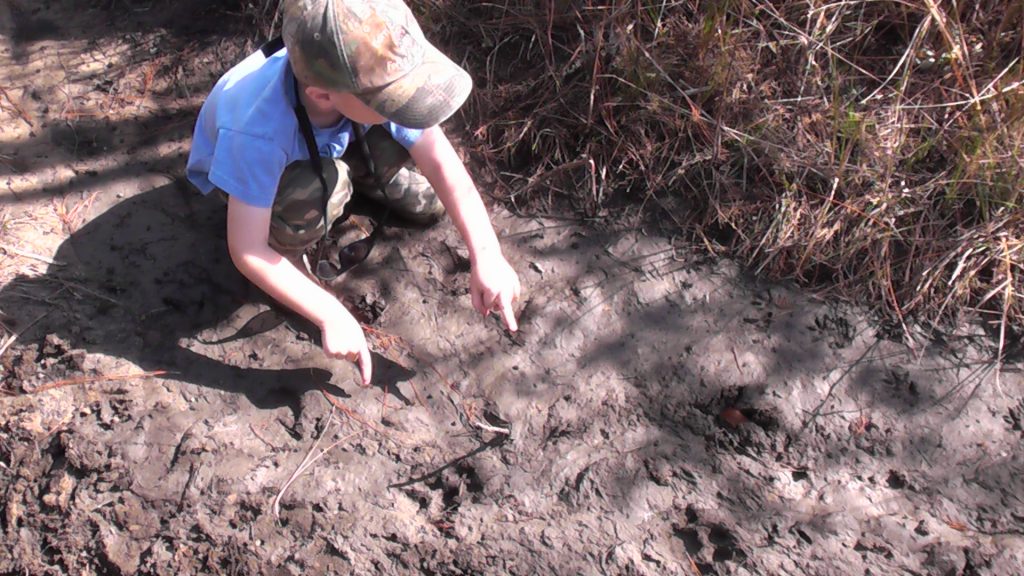 That's 5-year-old Cole Elfenbein, pointing at panther tracks in a buggy trail. The picture was taken off of Concho Billy Trail in the Turner River Unit of the Big Cypress Preserve last February. Proud father Mike Elfenbein took the picture.
That's 5-year-old Cole Elfenbein, pointing at panther tracks in a buggy trail. The picture was taken off of Concho Billy Trail in the Turner River Unit of the Big Cypress Preserve last February. Proud father Mike Elfenbein took the picture.
The November 2011 print edition of FS, now on newsstands, has a feature article on the past, present and future of Big Cypress National Preserve. Included are details on hunting, fishing and offroad vehicle access, as well as analysis of the federal-state partnership on a new management plan for the so-called Addition Lands.
Reef or Rack Outdoors was instrumental in setting up kids buggy rides in Big Cypress National Preserve last spring. Joe Palandro of Reef or Rack contributed the following special guest editorial for Floridasportsman.com. You can meet Joe and other RoR guys at one of the Florida Sportsman Shows around the state.
Big Cypress National Preserve: Vital for our Future
Twenty-eight years ago I was introduced to fishing, hunting, and the Outdoors by my father. Growing up in western Broward County gave us great opportunities to be able to drive through the woods and trails to our favorite fishing and hunting spots. We were able to do this because most of the land was undeveloped. With our population rising everyday and developers taking up more of the land, it is nearly impossible to find such places like I used growing up. This is why our National Parks and Preserves are so important.
Big Cypress National Preserve, for instance, was established in 1974 as the first Preserve in the National Park system. Big Cypress is comprised of 729,000 acres of beautiful cypress swamps, hardwood hammocks, palmetto uplands, and pine flats. This habitat serves as a great place for outdoorsmen and women such as myself and my family to enjoy hunting, fishing, camping, and recreational vehicle use. However, unfortunately the Park service and extreme environmentalists are doing everything they can to extremely limit or eliminate these activities, especially off road vehicle access.
The type of topography in Big Cypress is impossible to navigate by walking or everyday driving vehicles. If these stipulations are put in place, Big Cypress may as well close down completely. What good are our National Parks and Preserves if we can't utilize them?
National Parks, Preserves, as well as Wildlife Management Areas across the state serve a much bigger purpose than just a place to go and enjoy the outdoors. They serve as educational gateways to our youth with the programs that these places provide. Youth camps all over the state provide a place where children can go to experience the outdoors and learn from all it has to offer. Our children are the future of the conservation and preservation efforts set forth today to keep these beautiful lands the way they were when we used them growing up.
Take J.W. Corbett Wildlife Management Area located in northwestern Palm Beach County. They have a youth camp that has been going strong for nearly 35 years. The youth camp provides the opportunity to learn the outdoors with a wildlife oriented camping experience for kids ages 8-14. The camp is up to 96 campers per week and growing. Unfortunately the camps are uncertain of their future. The state wants to stop funding for such programs. Unless we keep writing our congressmen and let them hear our voice, these programs can be in jeopardy of being shut down. Remember every voice that is heard is one step closer to helping our children help the future of our National Parks, Preserves, and Wildlife Programs. So let's fight for what we believe in and do our part to help this great resource remain strong.
--Joe Palandro
Reef or Rack Outdoors
Following are some bonus photos by FS Editor Jeff Weakley and some friends of the Big Cypress:
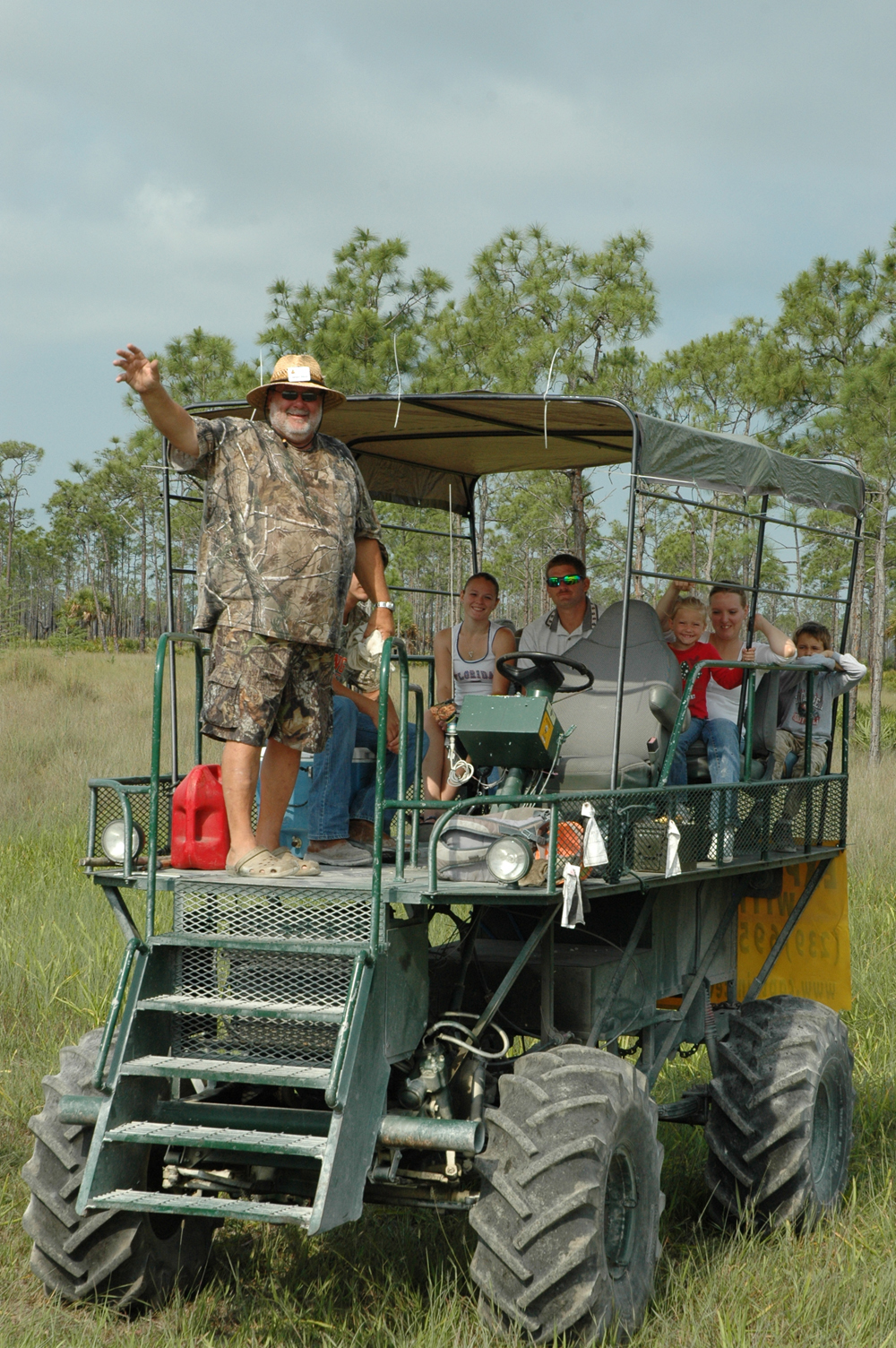 That's none other than Steve Markley, who volunteered to shuttle kids and families into Big Cypress last spring. Steve is mentioned in the print article in the November issue.
That's none other than Steve Markley, who volunteered to shuttle kids and families into Big Cypress last spring. Steve is mentioned in the print article in the November issue.
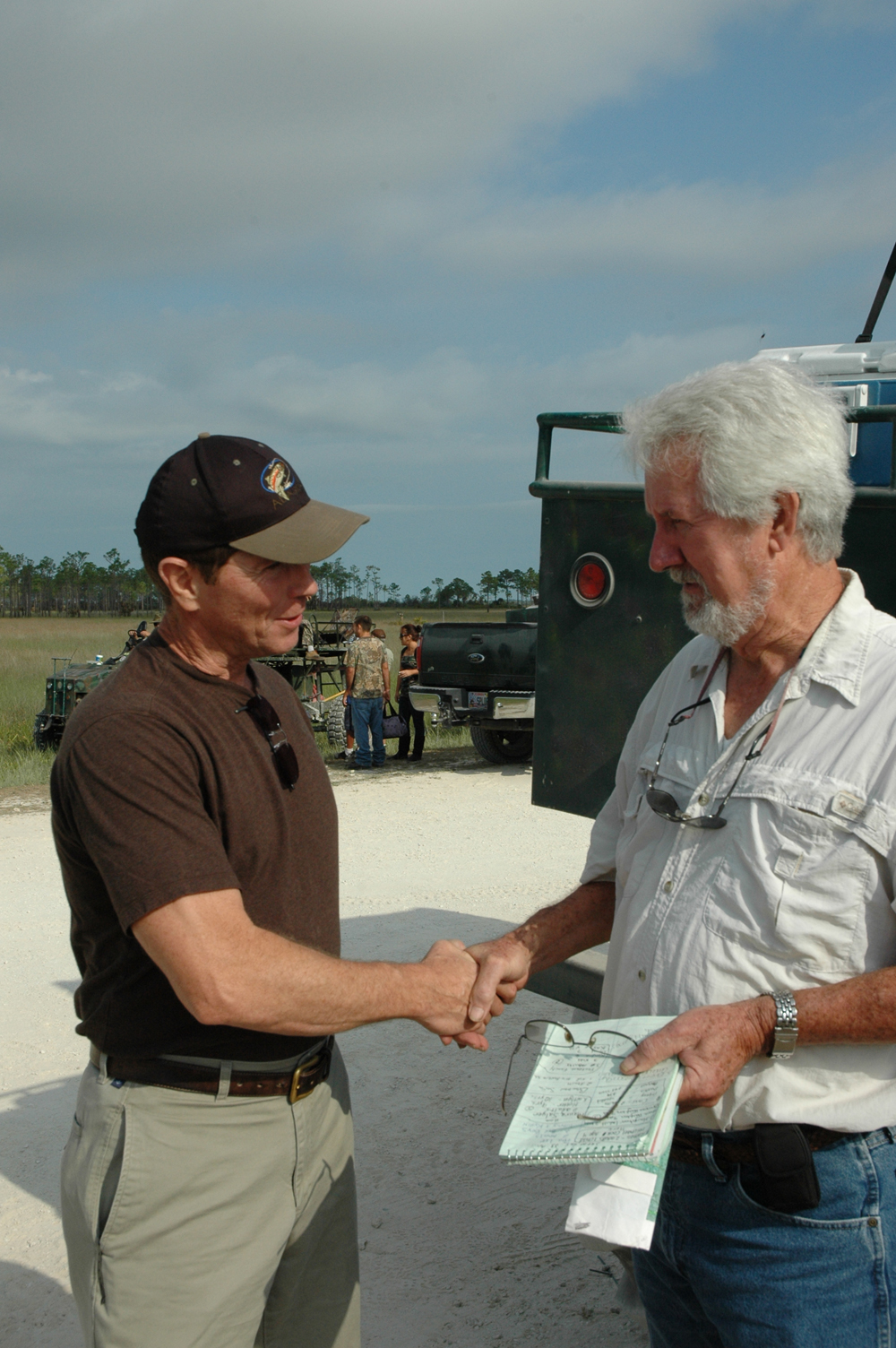 Chuck Collins (left), FWC Southeast Region Director, and Lyle McCandless of Big Cypress Sportsmens Alliance are in accord about the value of access to Big Cypress. “If we're going to preserve the environment, and preserve some of the traditions out in Big Cypress and throughout Florida, the key is getting youth in involved,” said Collins. “If they fall in love with this environment, they'll always work all their life to protect it.” Photo was taken in May 2011.
Chuck Collins (left), FWC Southeast Region Director, and Lyle McCandless of Big Cypress Sportsmens Alliance are in accord about the value of access to Big Cypress. “If we're going to preserve the environment, and preserve some of the traditions out in Big Cypress and throughout Florida, the key is getting youth in involved,” said Collins. “If they fall in love with this environment, they'll always work all their life to protect it.” Photo was taken in May 2011.
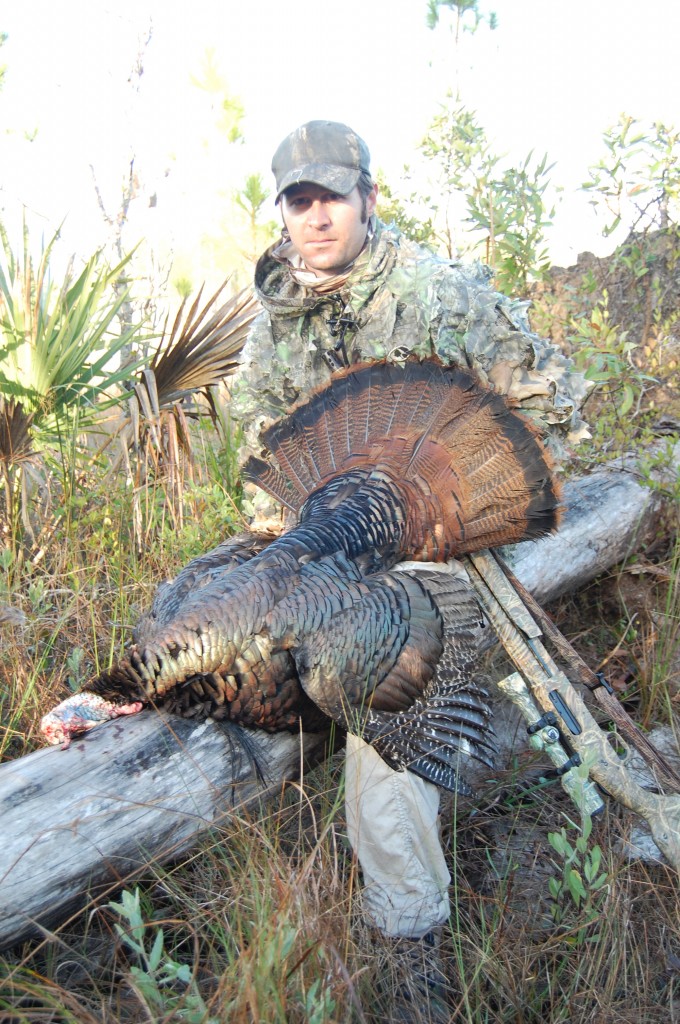 Fletcher Larkin with a turkey harvested in the Big Cypress, during Spring Turkey Season. Larkin and friend David Severns, both of Ft. Lauderdale, hiked in 5 miles with backpack gear.
Fletcher Larkin with a turkey harvested in the Big Cypress, during Spring Turkey Season. Larkin and friend David Severns, both of Ft. Lauderdale, hiked in 5 miles with backpack gear.
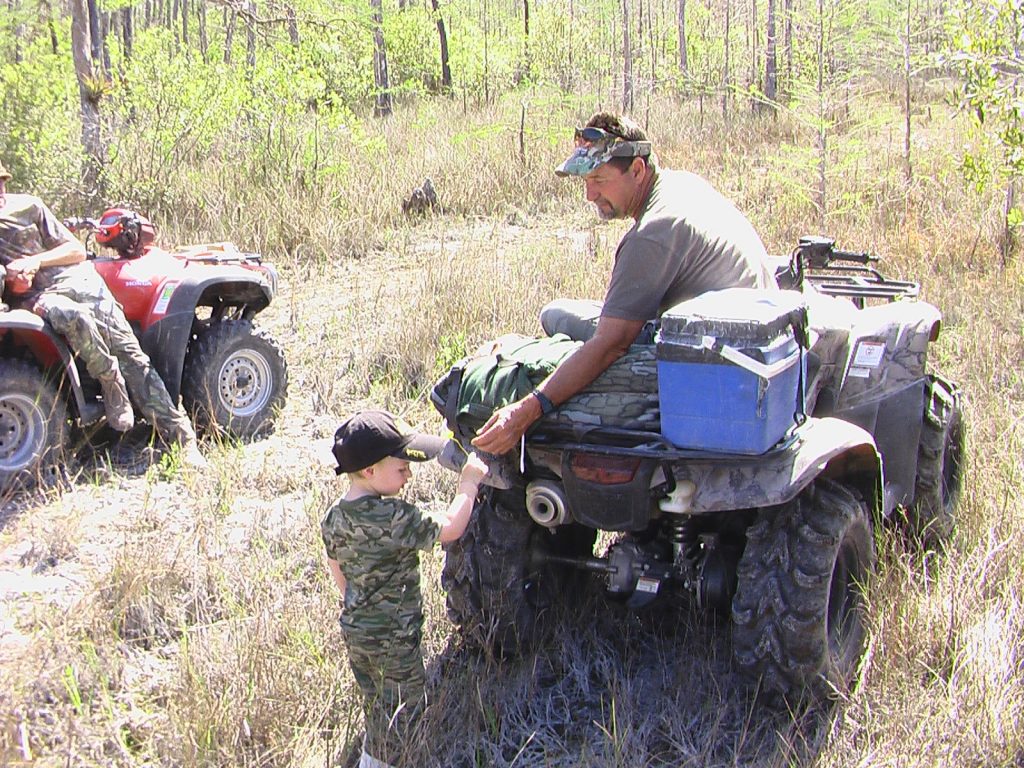
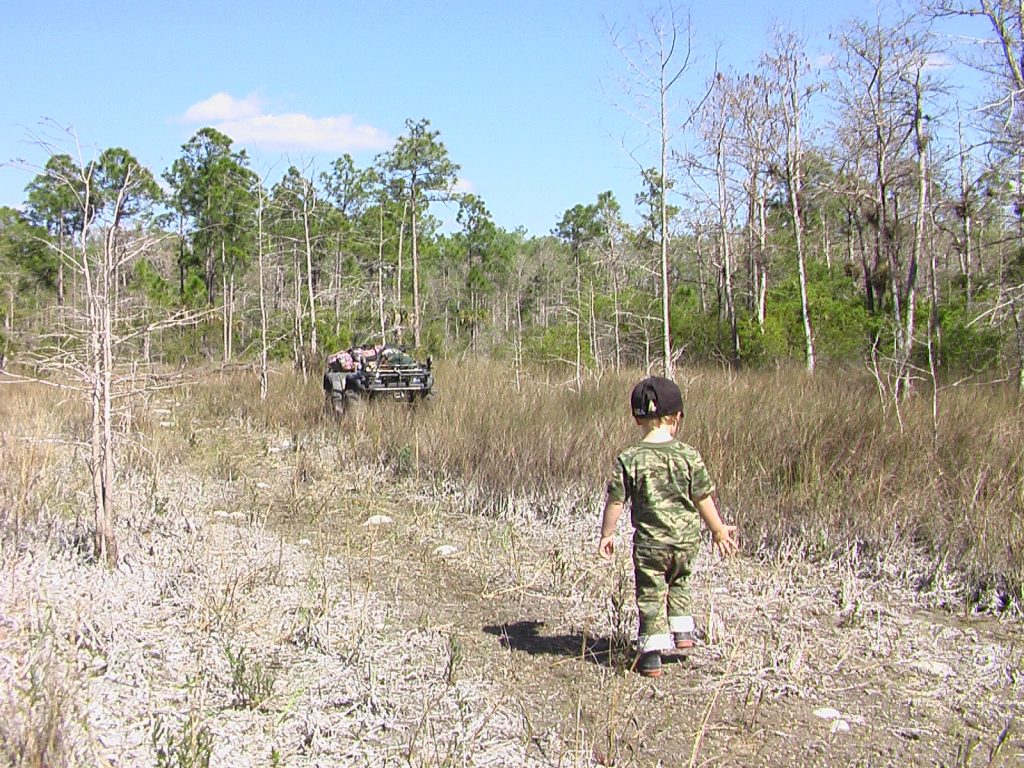 For children like Cole, ATVs and other offroad vehicles provide a vital means of accessing the interior of the preserve.
For children like Cole, ATVs and other offroad vehicles provide a vital means of accessing the interior of the preserve.
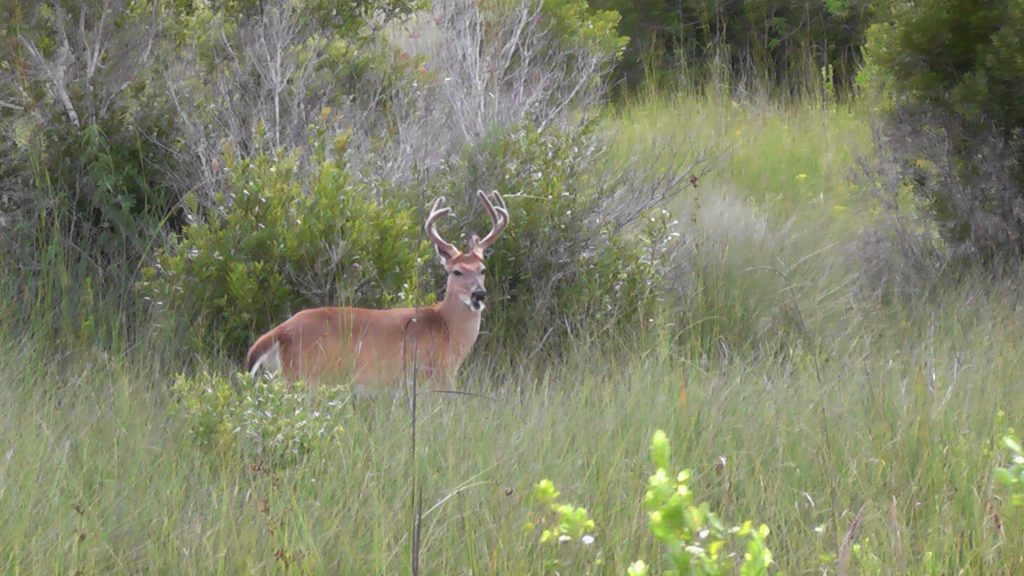 Mike Elfenbein sent in this photo, as well: a velvet buck in July 2011.
Mike Elfenbein sent in this photo, as well: a velvet buck in July 2011.
 Sunset in the Turner River Unit of Big Cypress, February 2011. Photo by Andrea Elfenbein.
Sunset in the Turner River Unit of Big Cypress, February 2011. Photo by Andrea Elfenbein.
“Oldie goldies” sent in by David Severns, photos of Jack Moller's family and friends.
[nggallery id=4]
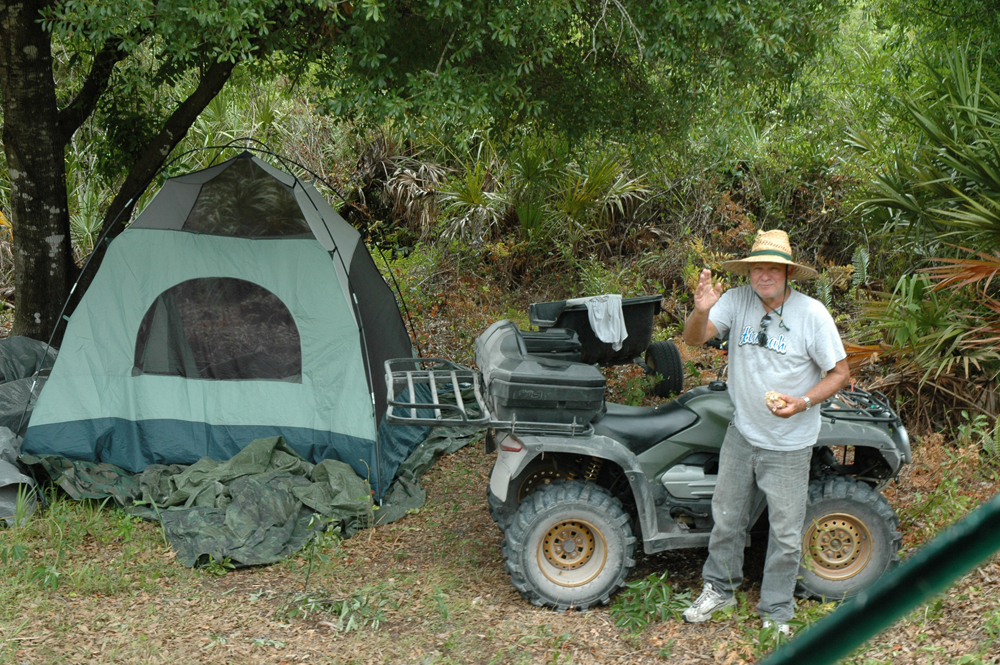
Some people would call him crazy, Dennis Wilson.
The Cooper City resident just loves to camp out in the Big Cypress. “It's breathtaking, just gorgeous out here.”
He offered some tips:
Rainfall: “You want to have a waterproof ground cover, and something waterproof over the top of the tent: String a line from one tree to another, put a big tarp over it. Because when it rains, it rains hard. You're gonna be sopping wet.
Creepy crawlies: “Never leave the tent open—not only will you get bugs and spiders in there, one day my wife and I were camping, and I heard her make a blood-curdling scream.. there's a big black racer in the tent. My friend and I had to take everything out, and dump it out.”
Black bears: “Don't worry about them. These bears are pretty shy, not aggressive like other places, where they're used to humans. You see a bear out here, usually they're running the other way.”
Drinking water: “Gotta pack it in. We take and freeze quart jugs. As they thaw you have water to drink, plus you can keep your stuff like meats and cheeses cold.”
Bonus: “You don't want to sit on any stumps in Big Cypress. When you get home you'll end up in the emergency room for red bugs!”
Contact the Preserve (239-695-1205;
www.nps.gov/bicy) for camping regulations and to obtain a free backcountry use permit.
>To get involved with the Big Cypress Sportsmens Alliance, find them on
Facebook.
Lyle McCandless, President of the Alliance, recently submitted this guest editorial to Florida Sportsman, in response to a news item:
HUNTERS FIGHT FOR ORV ACCESS TO BIG CYPRESS ADDITION LANDS
The National Parks Conservation Association recently filed a lawsuit against the National Park Service. The lawsuit is twofold. Count One claims that restricting ORVs (hunting Buggies) from 80 percent of the 147,000-acre Addition Lands is not enough. Count Two claims that the ORV Advisory Committee is unbalanced, that there are too many pro-ORV people and not enough anti ORV-people on the committee. The local leader of the National Parks Conservation Association and listed as co-plaintiff in the law suite is Mr. John Adornato. Mr. Adornato was recently re-appointed to the ORV Advisory Committee after being recently disallowed due to his questionable involvement in a national lobbying group. Great questions remain regarding this re-appointment. A person being temporarily inactive in a group that would otherwise disqualify them from a committee appointment doesn't cut it.
In response to Count One:
The Big Cypress National Preserve was established in 1974 by an act of Congress. The purpose of the Preserve creation was threefold: one, to protect the watershed into the Everglades National Park; two, to keep the land out of the hands of the developers; and three, to allow the continuation of the Traditional Cultural Activities including Hunting, Fishing, Frogging, Camping and ORV (hunting buggy) access. The Park Service and the anti-ORV community quickly figured out that since they couldn't do anything to stop hunting the next best thing was to restrict ORV access. The vast majority of the Preserve is only accessible by ORVs. Stop the ORVs, stop the hunters; hence their objective of banning ORVs from 80 percent of the 147,000-acre Addition Lands. At this point the public has been illegally denied access to the Addition Lands from the 1988 purchase date to today (23 plus years). Being denied ORV access to 80 percent of the Addition after the public waiting patiently for over 23 years is beyond unreasonable.
To date there is no documented evidence that ORVs have any long term negative impact on the environment. An ORV study conducted by the Big Cypress Sportsmen's Alliance during the 2008 hunting season established that there was an average of one ORV per five thousand acres of the Preserve during that three month [October thru December] hunting period. This three month period represents about 90 percent of the overall annual ORV activity in the Preserve; all facts, no fiction.
In response to Count Two:
I am not a member of the ORV Advisory Committee but I attend all meetings. I consider the Committee reasonably well balanced. I use the word reasonably for this reason: The minimum requirement for anyone being considered for the ORV Committee should be, one, that individual to have substantial knowledge of traditional ORVs in general; two, years of on the ground knowledge of the Preserve including ground conditions, season changes (high and low water), existing ORV trails etc.; three, a solid understanding of the Traditional Cultural past including the intent of the Preserve creation; and four, represent themselves only, not a specific group or groups.
The question is not whether ORVs and hunting is allowed; both activities are clearly allowed. With that in mind you do not need people on the committee who could have a bias against ORVs or hunting as in representing groups who clearly have a tract record of not being in general accord with hunting and ORV use.
Considering the fact that the intent of the Preserve legislation was to allow reasonable ORV access, the fair and reasonable process from day one would have been to identify all existing ORV trails. Map these trails, then charge the ORV Committee as qualified in 1 thru 4 above to eliminate only those trails that are unsustainable after clearly identifying unsustainable. Following this fair and reasonable process an ORV system could have been established in 12 months or less saving countless tax dollars to say nothing of the time and effort saved by the Committee and the Public not having to run back and forth to meetings for several years. A little common sense could have gone a long way.

